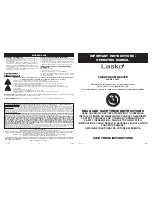
45
Banned fuel types
It is not allowed to stoke a fire with the following: printed matter, plywood, plastic, rubber, fluid fuels,
and rubbish such as milk cartons, lacquered wood or impregnated wood and fossil fuels. The reason that
you should not apply any of the above is that during combustion they develop substances that are health
hazardous and harmful to the environment. These substances could also damage your wood burning stove
and chimney, rendering the product warranty void.
Storage of wood
A water content of a maximum of 20% is achieved by storing the wood for a minimum of one year,
preferably two years, outdoors under a lean-to. Wood stored indoors has a tendency to become too
dry and combust too quickly. However, it might be advantageous to store fuel for lighting a fire indoors
for a few days prior to use.
Recommended dimensions
The dimensions of the fuel are important to good combustion. The dimensions should be as follows:
Fuel type
Length in cm
Diameter in cm
Wood for kindling a fire (finely chopped)
25-30
2-5
Chopped wood
25-30
7-9
Soapstone
Soapstone is a natural product that must be allowed to adapt to fluctuations in temperature, so great care
must be taken when stoking the stove the first few times. We recommend following the procedure below:
1. First stoking
Turn the regulator (drawing E, 1) clockwise to maximum. Put kindling with a diameter of between 2-5
cm, corresponding to about two pieces of wood, (maximum 2 kg) into the stove. Put two fire-lighters
between the top layers of kindling, light them and allow the flames to spread. Keep the door ajar until
condensation no longer forms on the glass (after about 5-10 minutes). Close the door. When the fire has
gone out, open the door and leave it open while the stove cools to room temperature.
2. Second stoking
Turn the regulator (drawing E, 1) clockwise to maximum. Put kindling with a diameter of between 2-5
cm, corresponding to about two pieces of wood, (maximum 2 kg) into the stove. Put two fire-lighters
between the top layers of kindling, light them and allow the flames to spread. Keep the door ajar until
condensation no longer forms on the glass (after about 5-10 minutes). Close the door.
When no more yellow flames are visible and a suitable layer of embers has built up, the stove can be
stoked again. There is a suitable layer of embers when the bottom of the stove is covered completely.
Half fill the combustion chamber with dry wood with a diameter of about 7-9 cm. When all of the wood
has caught fire, turn the regulator (1) to middle position. Allow the fire to burn and let the stove cool to
room temperature before stoking again.
3. Third stoking
Repeat the procedure for the second stoking, but put in more wood this time. Allow the fire to burn and
let the stove cool to room temperature after the fire has gone out.
Lighting the stove (drawing E)
Turn the regulator (1) clockwise to maximum. Put kindling with a diameter of between 2-5 cm, corre-
sponding to about two pieces of wood, (maximum 2 kg) into the stove. Put two fire-lighters between the
top layers of kindling, light them and allow the flames to spread. Keep the door ajar until condensation
no longer forms on the glass (after about 5-10 minutes). Close the door. When the kindling is burning
Summary of Contents for 3420
Page 2: ...2 ...
Page 4: ...4 B C A 3 1 1 4 45 4 3 2 1 D 9 11 10 17 1 6 5 7 8 2 3 15 4 16 4 3 14 12 13 11 12 14 14 15 ...
Page 5: ...5 F 6 2 1 3 4 5 G 3 0 E 1 ...
Page 6: ...6 H ...
Page 38: ...38 ...
Page 39: ...39 ...
Page 40: ......
Page 51: ......
Page 52: ...www hwam com ...








































